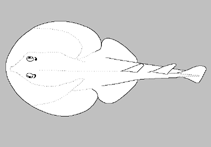http://www.fishbase.org/Summary/speciesSummary.php?genusname=Narcine&speciesname=insolita ---> http://192.134.151.83/Summary/speciesSummary.php?genusname=Narcine&speciesname=insolita
http://192.134.151.83/Summary/speciesSummary.php?genusname=Narcine&speciesname=insolita ---> https://fishbase.mnhn.fr/Summary/speciesSummary.php?genusname=Narcine&speciesname=insolita
https://fishbase.mnhn.fr/Summary/speciesSummary.php?genusname=Narcine&speciesname=insolita ---> https://fishbase.mnhn.fr/summary/Narcine-insolita.html
Narcine insolita, Madagascar numbfish

You can
sponsor
this page
Common name (e.g. trout)
Genus + Species (e.g. Gadus morhua)
-

-
About this page
-
Languages
-
User feedbacks
-
Citation
-
Uploads
-
Related species
-


 Madagascar numbfish
Upload your
photos
and
videos
Madagascar numbfish
Upload your
photos
and
videos
Google image
 No image available for this species;
No image available for this species;
drawing shows typical species in Narcinidae.
Elasmobranchii (sharks and rays) >
Torpediniformes
(Electric rays) >
Narcinidae
(Numbfishes)
Etymology:
Narcine:
Greek, narke = numbness (Ref.
45335
)
;
insolita:
Name from Latin 'insolitus' meaning unusual or uncommon; referring to the unusual and unique disparate dimensions of the dorsal fins, treated as an adjective (feminine).
.
Environment: milieu / climate zone / depth range / distribution range
Ecology
Marine; demersal; depth range 150 - 175 m (Ref.
93929
). Tropical; 15°S - 25°S, 42°E - 45°E (Ref.
114953
)
Western Indian Ocean: Madagascar.
Length at first maturity / Size / Weight / Age
Maturity: L
m
?
range ? - 35.6 cm
Max length : 35.6 cm TL (female)
Short description
Morphology
|
Morphometrics
Vertebrae
: 119 - 127. This species is distinguished from all its congeners by the following characters: unique presence of a very large and prominent first dorsal fin that is conspicuously taller, larger and with a longer base than the second dorsal fin; large spiracles, conspicuously rounded, not projecting anteriorly lateral to eyes, and with elevated rims all around; interspiracular distance much smaller than interorbital distance; small, broadly rounded lateral cusplets adjacent to principal cusp on teeth of more concealed inner rows; upper and lower tooth bands equal in width and broadly circular in outline; dorsal colouration composed of a yellowish brown background with darker brown to reddish brown irregular blotches on disc margins, posterior disc and anterior margin of snout; darker brown blotches on anterior portion of dorsal and caudal fins, at caudal apex, and laterally on tail at level of dorsal fins; precaudal vertebrae 68-71; total vertebrae 119-127 (Ref.
93929
).
Usually found over predominantly muddy substrata (Ref.
93929
). Maturity size of males at ca. 27 cm TL; birth size at ca. 14 cm TL (Ref.
114953
).
Life cycle and mating behavior
Maturity
|
Reproduction
|
Spawning
|
Eggs
|
Fecundity
|
Larvae
de Carvalho, M.R., B. Séret and L.J.V. Compagno
, 2002. A new species of electric ray of the genus
Narcine
Henle, 1834 from the South-western Indian Ocean (Chondrichthyes: Torpediniformes: Narcinidae). S. Afr. J. mar. Sci. 24:135-149. (Ref.
93929
)
IUCN Red List Status (Ref.
130435
)
Data deficient (DD)
; Date assessed:
24 April 2018
CITES
Not Evaluated
Not Evaluated
Threat to humans
Harmless
Human uses
FAO - Publication:
search
|
FishSource
|
More information
Countries
FAO areas
Ecosystems
Occurrences
Introductions
Stocks
Ecology
Diet
Food items
Food consumption
Ration
Common names
Synonyms
Metabolism
Predators
Ecotoxicology
Reproduction
Maturity
Spawning
Spawning aggregation
Fecundity
Eggs
Egg development
Age/Size
Growth
Length-weight
Length-length
Length-frequencies
Morphometrics
Morphology
Larvae
Larval dynamics
Recruitment
Abundance
BRUVS
References
Aquaculture
Aquaculture profile
Strains
Genetics
Electrophoreses
Heritability
Diseases
Processing
Nutrients
Mass conversion
Collaborators
Pictures
Stamps, Coins Misc.
Sounds
Ciguatera
Speed
Swim. type
Gill area
Otoliths
Brains
Vision
Tools
E-book
|
Field guide
|
Length-frequency wizard
|
Life-history tool
|
Point map
|
Classification Tree
|
Catch-MSY
|
Special reports
Check for Aquarium maintenance
|
Check for Species Fact Sheets
|
Check for Aquaculture Fact Sheets
Download XML
Summary page
|
Point data
|
Common names
|
Photos
Internet sources
AFORO (otoliths) |
Aquatic Commons
|
BHL
|
Cloffa
|
BOLDSystems
|
Websites from users
|
Check FishWatcher
|
CISTI
|
Catalog of Fishes
:
genus
,
species
|
DiscoverLife
|
ECOTOX
| FAO - Publication:
search
|
Faunafri
| Fishipedia |
Fishtrace
| GenBank:
genome
,
nucleotide
| GloBI |
Google Books
|
Google Scholar
|
Google
| IGFA World Record |
MitoFish
|
Otolith Atlas of Taiwan Fishes
|
PubMed
| Reef Life Survey | Socotra Atlas |
Tree of Life
| Wikipedia:
Go
,
Search
| World Records Freshwater Fishing |
Zoobank
|
Zoological Record
Estimates based on models
Phylogenetic diversity index (Ref.
82804
): PD
50
= 0.5000 [Uniqueness, from 0.5 = low to 2.0 = high].
Bayesian length-weight: a=0.01175 (0.00476 - 0.02897), b=2.88 (2.66 - 3.10), in cm total length, based on LWR estimates for this (Sub)family-body shape (Ref.
93245
).
Trophic level (Ref.
69278
): 3.1 ±0.3 se; based on size and trophs of closest relatives
Resilience (Ref.
120179
): Low, minimum population doubling time 4.5 - 14 years (Assuming fecundity<100).
Fishing Vulnerability (Ref.
59153
): Low to moderate vulnerability (26 of 100).
Back to Search
Random Species
Back to Top
Accessed through:
Not available
FishBase mirror site :
localhost
Page last modified by :
mrius-barile
- 20 July 2016
Fatal error
: Uncaught ArgumentCountError: Too few arguments to function checkEcotox(), 1 passed in /var/www/html/summary/speciessummary.php on line 2304 and exactly 3 expected in /var/www/html/includes/speciessummary.lib.php:2579 Stack trace: #0 /var/www/html/summary/speciessummary.php(2304): checkEcotox() #1 {main} thrown in
/var/www/html/includes/speciessummary.lib.php
on line
2579
|